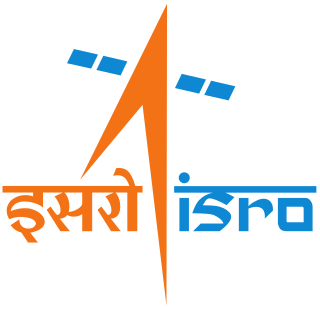
A spaceplane is a vehicle that can fly and glide like an aircraft in Earth's atmosphere and maneuver like a spacecraft in outer space. To do so, spaceplanes must incorporate features of both aircraft and spacecraft. Orbital spaceplanes tend to be more similar to conventional spacecraft, while sub-orbital spaceplanes tend to be more similar to fixed-wing aircraft. All spaceplanes to date have been rocket-powered but then landed as unpowered gliders.

The Indian Space Research Organisation is the national space agency of India, headquartered in Bangalore, Karnataka. Operating under the Department of Space (DOS), ISRO is India's primary agency for performing tasks related to space-based applications, space exploration and the development of related technologies. It is one of six government space agencies in the world which possess full launch capabilities, deploy cryogenic engines, launch extraterrestrial missions and operate large fleets of artificial satellites.
Hopper was a proposed European Space Agency (ESA) orbital spaceplane and reusable launch vehicle. The Hopper was a FESTIP system study design.

The Advanced Reentry Demonstrator (ARD) was a European Space Agency (ESA) suborbital reentry vehicle. It was developed and operated for experimental purposes, specifically to validate the multiple reentry technologies integrated upon it and the vehicle's overall design, as well as to gain greater insight into the various phenomenon encountered during reentry.

The Intermediate eXperimental Vehicle (IXV) is a European Space Agency (ESA) experimental suborbital re-entry vehicle. It was developed to serve as a prototype lifting body orbital return vehicle to validate the ESA's work in the field of reusable orbital return vehicles.
Scramjet programs refers to research and testing programs for the development of supersonic combustion ramjets, known as scramjets. This list provides a short overview of national and international collaborations, and civilian and military programs. The USA, Russia, India, and China (2014), have succeeded at developing scramjet technologies.

The Launch Vehicle Mark-3, previously referred as the Geosynchronous Satellite Launch Vehicle Mark III, is a three-stage medium-lift launch vehicle developed by the Indian Space Research Organisation (ISRO). Primarily designed to launch communication satellites into geostationary orbit, it is also due to launch crewed missions under the Indian Human Spaceflight Programme. LVM 3 has a higher payload capacity than its predecessor, GSLV Mk II.
The Indian Human Spaceflight Programme (IHSP) was initiated in 2007 by the Indian Space Research Organisation (ISRO) to develop the technology needed to launch crewed orbital spacecraft into low Earth orbit. The first uncrewed flight, named Gaganyaan 1, is scheduled to launch no earlier than 2023 on an LVM 3 rocket.

Vertical takeoff, vertical landing (VTVL) is a form of takeoff and landing for rockets. Multiple VTVL craft have flown. The most widely known and commercially successful VTVL rocket is SpaceX's Falcon 9 first stage.

The Space Capsule Recovery Experiment is an Indian experimental spacecraft which was launched at 03:53 UTC on January 10, 2007, from Sriharikota by the Indian Space Research Organisation (ISRO). The launch was conducted using the C7 launch of the PSLV rocket, along with three other satellites. It remained in orbit for 12 days before re-entering the Earth's atmosphere and splashing down into the Bay of Bengal at 04:16 UTC on January 22.
Avatar is a concept study for a robotic single-stage reusable spaceplane capable of horizontal takeoff and landing, by India's Defence Research and Development Organisation. The mission concept is for low cost military and commercial satellite space launches.

The Advanced Technology Vehicle is a modified Indian sounding rocket developed by the Indian Space Research Organisation (ISRO). It is based on the Rohini-560 rocket. The ATV program was created to test the development of a native dual-mode air-breathing scramjet engine. As of 2016, ISRO has flown two test missions.

Gaganyaan is an Indian crewed orbital spacecraft intended to be the formative spacecraft of the Indian Human Spaceflight Programme. The spacecraft is being designed to carry three people, and a planned upgraded version will be equipped with rendezvous and docking capability. In its maiden crewed mission, Indian Space Research Organisation (ISRO)'s largely autonomous 5.3 metric tonnes capsule will orbit the Earth at 400 km altitude for up to seven days with a two or three-person crew on board. The first crewed mission was originally planned to be launched on ISRO's LVM3 in December 2021, but this has since been delayed due to lockdown to no earlier than 2024.

Reusable Launch Vehicle Hypersonic Flight Experiment or RLV HEX was the first test flight in the RLV Technology Demonstration Programme of the Indian Space Research Organisation (ISRO). The demonstration trials will pave the way for a two-stage-to-orbit (TSTO) fully re-usable launch vehicle. HEX was successfully conducted on 23 May 2016.
Reusable Launch Vehicle–Technology Demonstration Programme is a series of technology demonstration missions that has been conceived by the Indian Space Research Organisation (ISRO) as a first step towards realising a Two Stage To Orbit (TSTO) re-usable launch vehicle.

The Crew Module Atmospheric Re-entry Experiment (CARE) is an experimental test vehicle for the Indian Space Research Organisation's future ISRO orbital vehicle called Gaganyaan. It was launched successfully on 18 December 2014 from the Second Launch Pad of the Satish Dhawan Space Centre, by a LVM3 designated by ISRO as the LVM 3X CARE mission. Total cost of mission was ₹155 crore. Cost of launch vehicle and CARE module was ₹140 crore and ₹15 crore.
The Programme for Reusable In-orbit Demonstrator in Europe (PRIDE) is an Italian Space Agency programme that aims to develop a reusable robotic spaceplane named Space Rider in collaboration with the European Space Agency.

RLV-TD is India's first uncrewed flying testbed developed for the Indian Space Research Organisation (ISRO)'s Reusable Launch Vehicle Technology Demonstration Programme. It is a scaled down prototype of an eventual two-stage-to-orbit (TSTO) reusable launch vehicle.

The Human Space Flight Centre (HSFC) is a body under the Indian Space Research Organisation (ISRO) to coordinate the Indian Human Spaceflight Programme. The agency will be responsible for implementation of the Gaganyaan project. The first crewed flight is planned for 2024 on a home-grown GSLV-III rocket.













